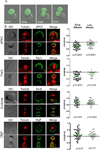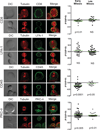Asymmetric cell division of T cells upon antigen presentation uses multiple conserved mechanisms
- PMID: 20530266
- PMCID: PMC3739982
- DOI: 10.4049/jimmunol.0903627
Asymmetric cell division of T cells upon antigen presentation uses multiple conserved mechanisms
Abstract
Asymmetric cell division is a potential means by which cell fate choices during an immune response are orchestrated. Defining the molecular mechanisms that underlie asymmetric division of T cells is paramount for determining the role of this process in the generation of effector and memory T cell subsets. In other cell types, asymmetric cell division is regulated by conserved polarity protein complexes that control the localization of cell fate determinants and spindle orientation during division. We have developed a tractable, in vitro model of naive CD8(+) T cells undergoing initial division while attached to dendritic cells during Ag presentation to investigate whether similar mechanisms might regulate asymmetric division of T cells. Using this system, we show that direct interactions with APCs provide the cue for polarization of T cells. Interestingly, the immunological synapse disseminates before division even though the T cells retain contact with the APC. The cue from the APC is translated into polarization of cell fate determinants via the polarity network of the Par3 and Scribble complexes, and orientation of the mitotic spindle during division is orchestrated by the partner of inscuteable/G protein complex. These findings suggest that T cells have selectively adapted a number of evolutionarily conserved mechanisms to generate diversity through asymmetric cell division.
Figures





Similar articles
-
Asymmetric T lymphocyte division in the initiation of adaptive immune responses.Science. 2007 Mar 23;315(5819):1687-91. doi: 10.1126/science.1139393. Epub 2007 Mar 1. Science. 2007. PMID: 17332376
-
Dendritic cell maturation controls adhesion, synapse formation, and the duration of the interactions with naive T lymphocytes.J Immunol. 2004 Jan 1;172(1):292-301. doi: 10.4049/jimmunol.172.1.292. J Immunol. 2004. PMID: 14688337
-
A role for CD40 expression on CD8+ T cells in the generation of CD8+ T cell memory.Science. 2002 Sep 20;297(5589):2060-3. doi: 10.1126/science.1072615. Science. 2002. PMID: 12242444
-
The use of carboxyfluorescein diacetate succinimidyl ester to determine the site, duration and cell type responsible for antigen presentation in vivo.Immunol Cell Biol. 1999 Dec;77(6):539-43. doi: 10.1046/j.1440-1711.1999.00868.x. Immunol Cell Biol. 1999. PMID: 10571675 Review.
-
Decisions on the road to memory.Adv Exp Med Biol. 2013;785:107-20. doi: 10.1007/978-1-4614-6217-0_12. Adv Exp Med Biol. 2013. PMID: 23456843 Review.
Cited by
-
Normalized polarization ratios for the analysis of cell polarity.PLoS One. 2014 Jun 25;9(6):e99885. doi: 10.1371/journal.pone.0099885. eCollection 2014. PLoS One. 2014. PMID: 24963926 Free PMC article.
-
Lineage Specification from Prostate Progenitor Cells Requires Gata3-Dependent Mitotic Spindle Orientation.Stem Cell Reports. 2017 Apr 11;8(4):1018-1031. doi: 10.1016/j.stemcr.2017.02.004. Epub 2017 Mar 9. Stem Cell Reports. 2017. PMID: 28285879 Free PMC article.
-
Immune synapse: conductor of orchestrated organelle movement.Trends Cell Biol. 2014 Jan;24(1):61-72. doi: 10.1016/j.tcb.2013.09.005. Epub 2013 Oct 24. Trends Cell Biol. 2014. PMID: 24119664 Free PMC article. Review.
-
The dynamic lives of T cells: new approaches and themes.Trends Immunol. 2013 Feb;34(2):59-66. doi: 10.1016/j.it.2012.10.006. Epub 2012 Nov 28. Trends Immunol. 2013. PMID: 23200626 Free PMC article. Review.
-
Polarity of CD4+ T cells towards the antigen presenting cell is regulated by the Lck adapter TSAd.Sci Rep. 2018 Sep 6;8(1):13319. doi: 10.1038/s41598-018-31510-6. Sci Rep. 2018. PMID: 30190583 Free PMC article.
References
-
- Williams MA, Bevan MJ. Effector and memory CTL differentiation. Annu Rev Immunol. 2007;25:171–192. - PubMed
-
- Russell SM. Determination of T-cell fate by dendritic cells: a new role for asymmetric cell division? Immunol Cell Biol. 2008;86:423–427. - PubMed
-
- Chang JT, Palanivel VR, Kinjyo I, Schambach F, Intlekofer AM, Banerjee A, Longworth SA, Vinup KE, Mrass P, Oliaro J, Killeen N, Orange JS, Russell SM, Weninger W, Reiner SL. Asymmetric T lymphocyte division in the initiation of adaptive immune responses. Science. 2007;315:1687–1691. - PubMed
-
- Reiner SL, Sallusto F, Lanzavecchia A. Division of labor with a workforce of one: challenges in specifying effector and memory T cell fate. Science. 2007;317:622–625. - PubMed
Publication types
MeSH terms
Grants and funding
LinkOut - more resources
Full Text Sources
Other Literature Sources
Research Materials
Miscellaneous

